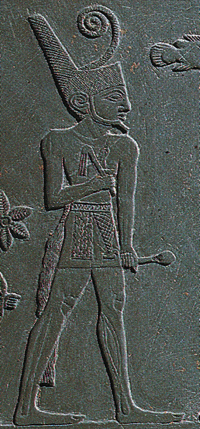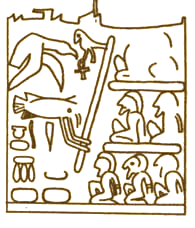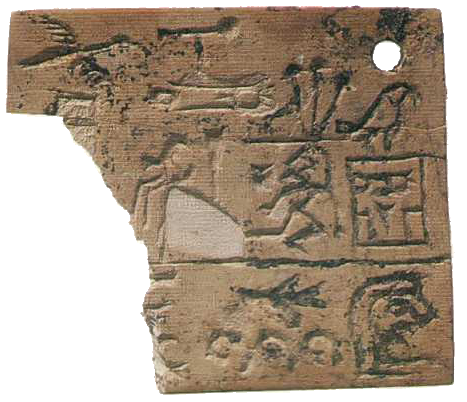
Horus Narmer is usually considered the first king of the 1st Dynasty, perhaps even the first to have ruled over the whole of Egypt, or as the last king of the Predynastic Period. He is one of the first Egyptian kings to have left some historical records.
Very little is known about the king we call Horus Narmer. Even the reading and meaning of his name are not certain. What we do know is that his name has been found throughout Egypt, which is sometimes interpreted that Narmer was the first king to have ruled over he whole of Egypt. That sources mentioning Narmer's supposed predecessors haven't been found to the same extent may have more to do with the fact that the number of sources containing writing that predate Narmer is very low.
Narmer's name has also been found outside Egypt, in Syria-Palestine, indicating that there was an active trade going on between Egypt and parts of the Ancient Near East.
Two pits found at Umm el-Qa’ab, near Narmer’s own modest tomb, refer to Horus Ka and Horus ‘Mouth’ (or Iri-Hor) whose names have also been found in Lower Egypt. The proximity of their tombs to Narmer’s suggests that they were among his direct predecessors.
A king named “Scorpion", whose name is recorded on a ceremonial macehead found at Hierakonpolis, is sometimes interpreted as a predecessor of Narmer. The stylistic similarities between this macehead and several artefacts bearing the name of Narmer, which have also been found at Hierakonpolis, put “Scorpion" in close proximity to Narmer. This has led some researchers to believe that he was either Narmer's immediate predecessor or a rival king who ruled in the south of the country. In the former case, however, one would expect a tomb for “Scorpion” not too far away from Narmer’s in Umm el-Qa'ab. And in the latter case, it is surprising that further traces of a king “Scorpion” at Hierakonpolis are very rare, nor have we found any source from the time of Narmer to indicate a battle against a kingdom in the south of Egypt.
Destruction of city walls by different animals, assumed to symbolise a king.
Source: Tiradriti, Egyptian Treasures, p. 38.
Another source contemporary to Narmer and found in the Fayum Oasis, refers to a king using the imagery of a crocodile. If this too was a rival king, then Narmer would have conquered Hierakonpolis to the south of his Thinite kingdom, the Fayum to the northwest and at least some parts of the Delta to the north. When we have a look at the so-called City Palette, which, again in a style very similar to that of the Narmer Palette, shows several animals hacking into the wall of a city, it could also be suggested that one king may have identified himself through different animals. If that is the case, then it is also possible that “Scorpion” and “Crocodile” may perhaps have been none other than Narmer himself!
It is generally assumed that Narmer was married to a queen named Neithhotep. This is based on the assumption hat Neihhotep was Horus Aha's mother and that succession went from father to son, making Narmer Aha's father. As there is no known source that places Narmer and Neithhotep in the same context, this assumption cannot be confirmed.

The Catfish, symbol of Narmer, striking down its foes. Ivory label found in Hierakonpolis, now in the Ashmolean Museum in Oxford.
Some of the sources mentioning Narmer confirm that he was a warrior king. A year label from his reign records a victory of a people living in a marshland. This may or may not be the same victory as the one recorded on the Narmer Palette, which also appears to record the creation of the province of Mareotis in the eastern part of the Nile Delta.
Another label shows the catfish, symbol of Narmer, striking down a series of bound enemies. From the accompanying text, it may inferred that the enemies are identified as Tshehenu, 'Libyans', which could point to a battle in the western part of the Nile Delta.
Narmer's military activity in the Nile Delta may confirm that he annexed at least part of Lower Egypt to his realm, and may be one of the sources pointing to him as the king who unified Upper and Lower Egypt. This is one of the achievements that could identify him with the almost legendary king Menes, whom Ancient Egyptian tradition credits for being the first king to have ruled over the whole of Egypt.

This year label of Narmer shows the Catfish, symbolising Narmer’s name, striking down a foe identified by a marshland. Although different in style, the event depicted here closely resembles the one on the Narmer Palette.
Source: EEF Archive.
Menes was not only the king believed to have united Upper and Lower Egypt, he was also said to have founded Memphis, the country’s new capital, approximately on the border of Upper and Lower Egypt. As the oldest known large tombs in that region, more precisely in the north of Saqqara, are dated to the reign of Horus Aha, many researches believe that the city was founded by Aha, which would equate him, not Narmer, to Menes.
One of the many names of Memphis was inb-HD, usually translated as “White Wall” and written by combining the hieroglyphs representing a wall and a mace. A seal impression found to the south of Memphis, shows Narmer’s name written inside a wall, connected to a mace. The combination of wall and mace can be understood as inb-HD, and may have resulted in later generations crediting Narmer with the founding of the “White Wall”, Memphis.

Drawing of a seal impression that combines Narmer’s name with signs that represent a wall (square) and a mace, and that could be read as the ancient name of Memphis.
Source: Kaplony, Inschriften der ägyptischen Frühzeit, Band III, Tafel 18, abb. 34.
Other sources, such as two seal impressions found at Umm el-Qa'ab, also appear to indicate that when later generations of Egyptian chroniclers compiled the Kinglists, they may have had Narmer in mind as the founder of their country.
Despite Narmer’s later possible status, he was buried in a tomb at Umm el-Qa'ab, to the west of Abydos, that seems quite modest compared to that of his successors.